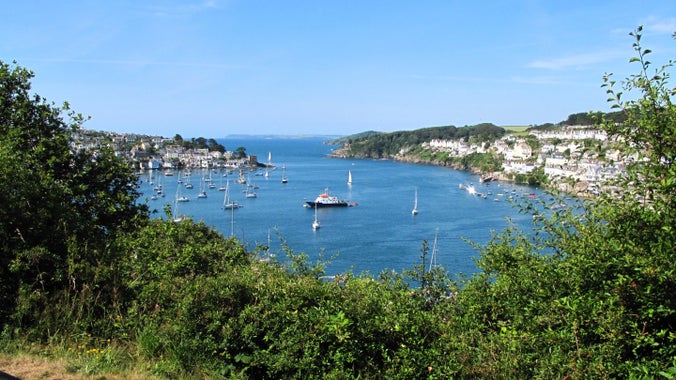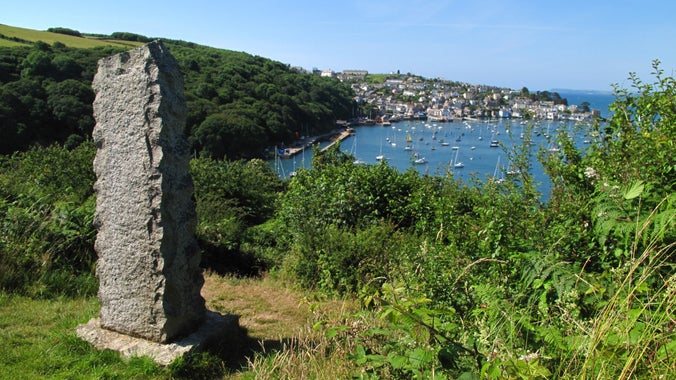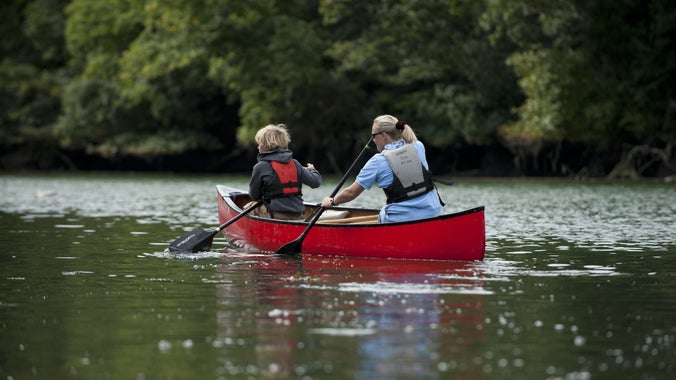
Discover more in Cornwall
You can find exotic gardens, ancient houses and mining history encircled by a much-loved coastline.

There are some great walks around Fowey, with dramatic stretches of the South West Coast Path weaving through woodlands and around creeks. They range from a short amble around Covington Woods to taking in both sides of the estuary on Hall Walk if you've got more time to play with.
Find out more about the local geography of Cornwall’s Fowey Estuary and the best places to go.
The Fowey Estuary runs inland as far as Lostwithiel, and branches off to Lerryn, Penpoll and Pont on its tributary creeks. It should be called a 'ria' as the drowned river valley networks are really a part of the sea.
The deep water makes it an important port and you'll often see cruise liners stopping off as well as China clay ships, which take away around three quarters of a million tonnes of clay each year.
Familiarly known as The Gribbin, this elegant headland lies to the west of Fowey Harbour and is crowned by the Gribbin Daymark. Standing 84ft tall, the proud red and white stripes of the daymark act as a navigational aid for shipping.
On Sundays in the summer our volunteer team welcome visitors to climb the daymark tower. Please note, however, that in 2024 we are unable to have our usual open days whilst we work on vital repairs. We hope to be able to re-open the doors , when the tower is safe for us to climb once again.
The headland is on the South West coast path, and a short walk from nearby Polkerris on one side and Polridmouth, Coombe Haven and Fowey on the other.
For a moderate walking round the headland and nearby Coombe, follow the steps on this downloadable trail: Gribbin Head walk
This area has been farmed for at least 2,000 years. To the north of the car park is an iron-age settlement and there is evidence of a medieval hamlet and field systems down towards the cliffs. The old farm house was once a dower house for the Rashleigh widows from the nearby Menabilly Estate. Down on the beach at Coombe Haven smugglers would haul up their loot, but nowadays it's a perfect spot to sit and gaze out over the water enjoying the peace and quiet.
Walk through Allday's Field on the way to Fowey and discover Covington Wood, and just beyond, on the cliff is the remains of the Tudor castle. St Catherine's was part of a coastal defence system ordered by Henry VIII. The site hints of an earlier medieval motte and bailey too.
30 acres of meadow and woodland next to Caffa Mill, near the Fowey slipway for the Bodinnick ferry. A quiet space for gentle walks on the doorstep to Fowey town centre.
In the upper reaches of the Fowey, the tide creeps up Lerryn Creek twice a day. Ethy Wood extends along its bank from Lerryn to Ethy Rock.
There are a whole network of footpaths up and around the woodland and by the water's edge. Take a stroll past contorted veteran oaks and keep your eyes peeled for kingfishers and egrets.

Pont Pill is a silent, private place where old boats go to die and trees are shrouded with traveller's-joy. Explore this creek from Fowey Harbour either by water or on foot on Hall Walk.
This western gatepost at the entrance to Fowey harbour is home to St Catherine's Castle: part of a chain of castles along the south coast ordered by Henry VIII.
Fowey has inspired many authors over the years, most notably Daphne Du Maurier who lived in a few houses on both sides of the estuary. Walk around Menabilly and Polridmouth beach and imagine scenes from her book Rebecca.
Sir Arthur Quiller Couch, nicknamed Q, came originally from nearby Bodmin and was also influenced by the area. Look for his memorial above Bodinnick on Hall Walk.
Leo Walmsley lived in a humble cabin near the water's edge up the creek from Polruan and wrote a beautiful account of his time there, while Kenneth Grahame was reportedly inspired by the area which led him to write The Wind in the Willows.

You don't have to be an avid sailor or expert angler to enjoy messing around on the estuary. This quiet backwater can become quite a busy place in the warmer months, but don't let that stop you from picking up your rod or paddle.
There are lots of great fishing spots around the estuary, both onshore or from a boat. Try your hand at catching mackerel, bass, wrasse, conger eels and pollock, which proliferate in these waters.
If you don't have your own boat or kayak then there are plenty of fishing trips to book yourself onto.

Explore the scenic wooded creeks of the estuary in a canoe. The view from the water certainly provides a new perspective of the surrounding land. There are various places to launch your own canoe as well as self-hire and guided trips to join.
Paddle up the river to explore the tributaries leading up to Lerryn and Lostwithiel, or back downstream to follow a shoal of mullet. You may spot a shy otter or a pod of dolphins if you're lucky, but please remember to keep your distance and respect all other creatures that share the water.
Fowey has been an international trading port since the Middle Ages and is still a magnet for visiting yachtsmen today. The deep water makes it easy to get into and out of at any tide and there are plenty of self-hire boats and boat trips available.
It's always good to know what the tide and weather are doing when you are by the coast. Our local NCI weather station at Polruan is great for checking wind conditions too.

You can find exotic gardens, ancient houses and mining history encircled by a much-loved coastline.

Help to look after National Trust places by observing a few simple guidelines during your visit and following the Countryside Code.

Explore the beach, go fishing, take in the clifftop views and walks around Lantic Bay and Pencarrow Head.

This charming dog-friendly cottage is just metres from a winding Cornish tidal creek and surrounded by woods.

A cosy cottage just metres from a winding Cornish tidal creek surrounded by woods.

A converted farmhouse, this character-packed cottage sits on the wooded banks near the head of a winding tidal creek.


Discover the places to visit in and around this Cornish village, including sandy coves, ancient churches, old water mills and landmarks from its smuggling heyday.

Explore places to visit around Polperro, Looe and Whitsand Bay, from great surfing beaches to idyllic fishing villages. Find out about seaside activities, including swimming, fishing and rock-pooling.